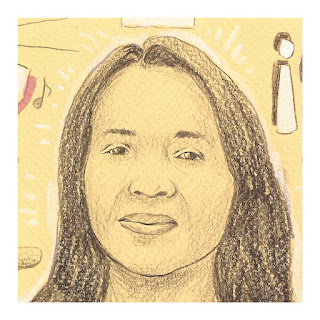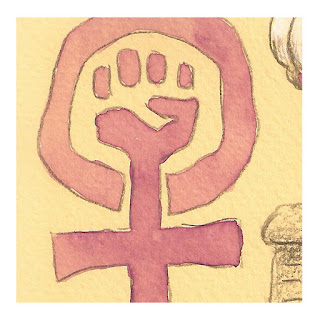Who is She 33? – Dolores Huerta
Short version:
So this will be my only new piece for Women’s History Month 2019. It’s a larger illustration of Dolores Huerta featuring many symbols that represent parts of her life both big and small. Dolores is one of the most revolutionary women living. As the co-founder of the United Farm Workers Union her selfless activism and organizing helped to not only change the lives of the farm workers across California, but it continues to inspire young women and people all over the world.
It is a crime that more attention, respect, and admiration is not given to her. I just finished working on a project about her and had the chance to learn a lot more about her. But, if you’re not familiar with Dolores, I highly recommend watching the most recent documentary by Peter Bratt. It will give you a good glimpse into her life. Then go check out her foundation because she is still organizing! I give Dolores and her family so much respect and thanks. Happy women’s day!
Longer Version:
So, here is a slightly longer version but I am not going to go over her entire life just some of the words, drawings, and symbols I included. I would highly suggest watching the documentary if you are not a reader. If you’re a reader go check out her foundation.
Stockton– Ok so Dolores was born in Dawson New Mexico, but she grew up in Stockton California. Although her dad was a farm worker and organizer, she was raised by her mom and siblings. There she watched her mom hold down jobs and eventually run a hotel which was not a typical thing for most women to do in the 30s. It was through her mom that she got her first feminist role model; saying that she never had to cater to her brothers. Her mother made them all work equally; which is often not the case in some Latinx families. Dolores attended school in Stockton in what was a very mixed setting, but she also experienced racism there in the treatment of students of color and her education.
Dancing/Jazz-Dolores loved to dance and she loves music. One of her favorite genres is Jazz. She helped organize a dance, danced herself, and made time to go see musicians play live.
Fred Ross-After working as a teacher and witnessing the conditions the children of farm workers lived in she dedicated her life to organizing. It is then that she met Fred Ross who ran the Community Service Organization (CSO). He taught Dolores about organizing and she became a bad ass at it. She was so persuasive and hard working that they soon promoted her to take policy changes to the states capitol.
Cesar Chavez-Another bad ass who worked with and was trained Fred Ross is Cesar. Cesar grew up as a child of farm workers and understood their experiences first hand. He was also a star at organizing and soon Fred was partnering Cesar and Dolores up. Cesar would also go on to be one of the most revolutionary activists of his time.
NFWA-National Farm Workers Association– Together Dolores and Cesar left the CSO and co-founded a small organization aimed at specifically organizing Latinx farm workers in Central California. They called it an association rather than a union because unions were outlawed and union organizers were being hunted.
Huelga sign– After getting a jump from the Filipino workers AWOC (Agricultural Workers Organizing Committee) they joined forces with Dolores and Cesar to form what would become world famous as the United Farm Workers or UFW. The symbol for their flag inspired by Aztec iconography and later becoming a symbol for organizing, social justice, and Chican@ pride. The word Huelga means “strike” in both Spanish and Tagalog the languages spoken by the multicultural UFW.
Si! Se Puede!– Dolores was a leader who often went into towns, cities, and communities to speak with folks, hear their needs, and to organize them. She did this with wit, strength, and humility. But, if anyone ever told her she couldn’t do something which both white folks and macho men of color often did, she’d say yes we can. Si Se Puede! Which is a slogan she came up with and was later used by Barack.
The Feminist fist– I included this because although Dolores was brought up Catholic in a traditional Latinx family she was brought up with some very feminist ideas. And when she met feminists on a trip to NYC to promote the grape strike of the mid 60s she gained some new ideas. At first she didn’t rock with all of what they said, but then slowly she started to change her mind, incorporating them into her life. This is important, because of in el movimiento there can be sexism. Women from the Black Panther Party have spoken about this as well.
Family-So Dolores amazingly had 11 children! She now has 17 grand kids as well. So, as a movement parent she lifted up farm workers and fought for revolutionary causes. She worked tirelessly to do this for decades. But, her family life was sacrificed in many cases. She got married three times and often was away organizing. Her grown children have not held back in saying they were sometimes angry with her, left behind, or frustrated. They understand why she did what she did, but it was not easy. Somehow with little to no money (organizers don’t get paid often) she raised and got help raising her kids.
Billy club- I put that in there because she was beaten by the San Francisco Police Department. They broke her ribs and she had to be hospitalized. She has been arrested over 20 times in her life.
Why? Ok, so why did Dolores do all this work? Why sacrifice? A couple of reasons. The Mexican and Latinx workers who grew, picked, and serviced the farm lands that feed the United States were being exploited. They were being ripped off financially. Whenever possible the white farm owners undercut their pay. leaving them with not enough money to pay for proper housing (Dolores’ mom often let workers stay for free because of this) , food, clothing, and/or schooling for their kids. Their kids could not attend school, they had to work in the fields to help support the family. The working conditions were horrible. Imagine bending over all day to pick fruits and vegetables without proper breaks, no drinking water, no bathrooms, or shade. Workers were . threatened if they asked for these things and fired if they attempted to form a union. They had no sick time, no benefits, no regular raises, and no support if they got ill. Lastly, the farm owners were poisoning their workers as they worked them to death (life expectancy was in the 50’s). The farm owners had their fields sprayed with harsh chemicals such as DDT known to cause cancer. Because of all this Dolores was passionate about fighting for these workers.
Victory-And you know what? They organized among the Filipino and Latinx workers striking for years, bringing down a boycott that reached across the US . This eventually took so much money out . of the growers pockets that they forced them to the negotiating table, winning better working conditions, rights, and pay for the families. Dolores is a bad ass!
There’s a lot I’m leaving out, but please check out more of the drawing and go find out more about this woman’s life! If you wanna see more women I’ve drawn for Women’s History Month check these past examples:
March 28, 2019
in General, Who is She?
No Comments










